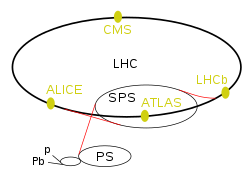 NA61 Experiment Logo | |
| Formation | Data taking started on 18-04-2008 |
|---|---|
| Headquarters | Geneva, Switzerland |
Leader of Experiment | Marek Gazdzicki |
| Website | https://shine.web.cern.ch/ |
 | |
| Key SPS Experiments | |
|---|---|
| UA1 | Underground Area 1 |
| UA2 | Underground Area 2 |
| NA31 | NA31 Experiment |
| NA32 | Investigation of Charm Production in Hadronic Interactions Using High-Resolution Silicon Detectors |
| COMPASS | Common Muon and Proton Apparatus for Structure and Spectroscopy |
| SHINE | SPS Heavy Ion and Neutrino Experiment |
| NA62 | NA62 Experiment |
| SPS preaccelerators | |
| p and Pb | Linear accelerators for protons (Linac 2) and Lead (Linac 3) |
| (not marked) | Proton Synchrotron Booster |
| PS | Proton Synchrotron |
NA61/SHINE (standing for "SPS Heavy Ion and Neutrino Experiment") is a particle physics experiment at the Super Proton Synchrotron (SPS) at the European Organization for Nuclear Research (CERN).[1] The experiment studies the hadronic final states produced in interactions of various beam particles (pions, protons and beryllium, argon, and xenon nuclei) with a variety of fixed nuclear targets at the SPS energies.
About 135 physicists from 14 countries and 35 institutions work in NA61/SHINE, led by Marek Gazdzicki. NA61/SHINE is the second largest fixed target experiment at CERN.
- ^ Antoniou, N.; et al. (NA61/SHINE Collaboration) (2006). "Study of hadron production in hadron–nucleus and nucleus–nucleus collisions at the CERN SPS". Proposal. SPSC-P-330, CERN-SPSC-2006-034.